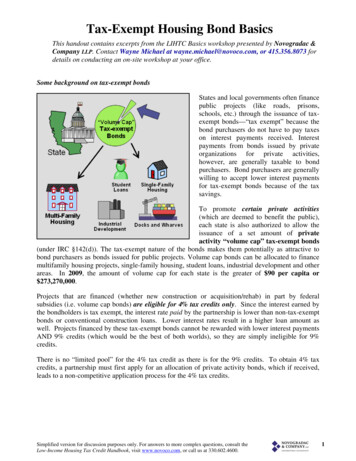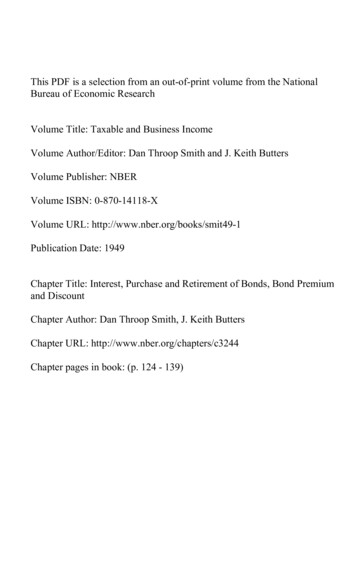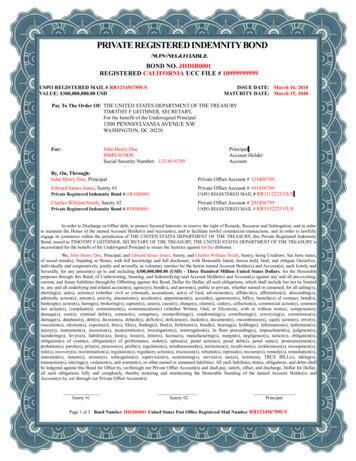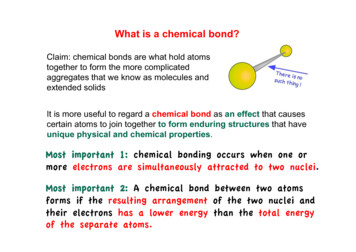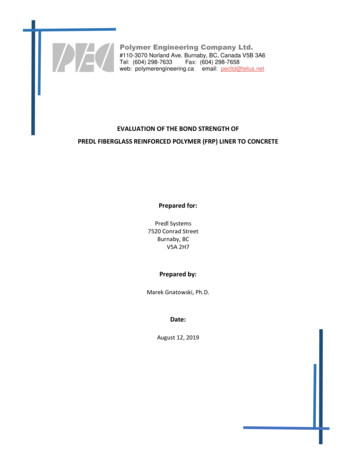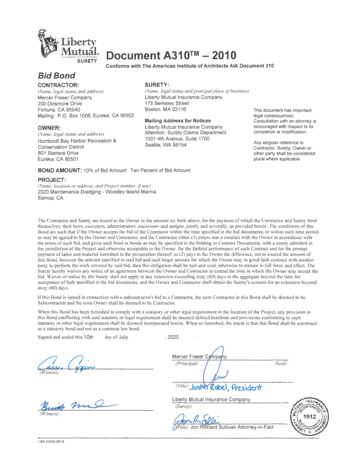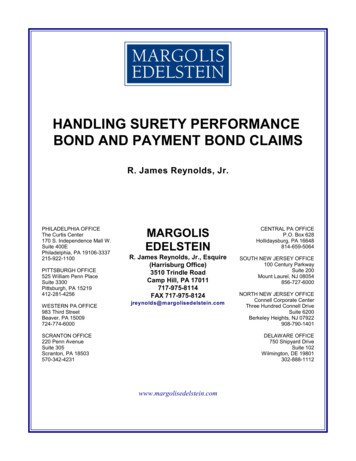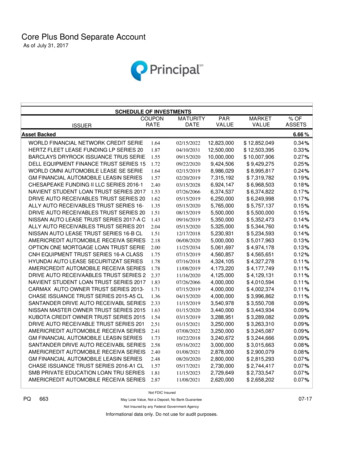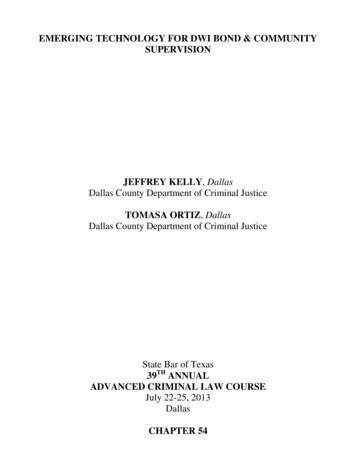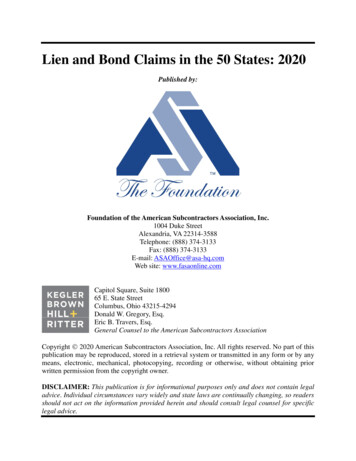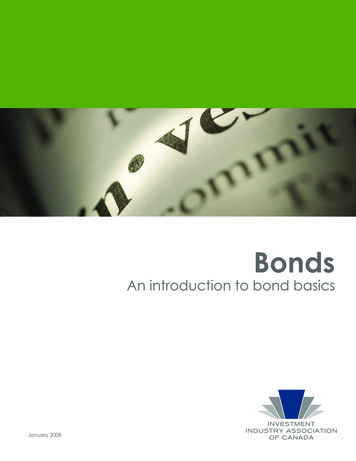
Transcription
BondsAn introduction to bond basicsJanuary 2008
The information contained in this publication is for general information purposes only and is not intendedby the Investment Industry Association of Canada as investment advice or a recommendation on theappropriateness of bond investing.2 – BONDS: AN INTRODUCTION TO BOND BASICSINVESTMENT INDUSTRY ASSOCIATION OF CANADA
For an investor, bonds are just one of the wide varietyof options available to choose from when building aninvestment portfolio.Before investing in bonds, it’s important to have a general understandingof what they are and the potential advantages and risks they carry.This brochure provides a plain-language introduction to bonds. Itexplains what a bond is, why think about investing in bonds, the risks ofbond investing and how bonds are bought and sold.TABLE OF CONTENTSBond basicsWhat is a bond?How are bonds different from stocks?33What are the benefits of investingin bonds?Income predictabilitySafetyDiversificationChoice4444What are the risks of bond investing?The risk of default (also known as credit risk)Price risk55How do I invest in bonds?Paying for your bonds8A final word8More detailed information on bonds is available in the publicationBonds: More on bond investing. Download your free copy at www.iiac.ca.INVESTMENT INDUSTRY ASSOCIATION OF CANADABONDS: AN INTRODUCTION TO BOND BASICS – 3
bond basicsInterest and dividendsare taxed differently.Although typically the taxtreatment of the interestand capital gains on bondsis straightforward, certainbonds can have special taximplications that investorsshould be aware of. Checkwith your investmentadvisor.What is a bond?A bond is a type of investment that represents a loan between a borrower and alender. Think of it as similar to getting a personal loan from a bank – except in thiscase you are the lender (known as the investor or creditor) and the borrower isgenerally a government or corporation (known as the issuer).With bonds, the issuer promises to make regular interest payments to the investor ata specified rate (the coupon rate) on the amount it has borrowed (the face amount)until a specified date (the maturity date). Once the bond matures, the interestpayments stop and the issuer is required to repay the face amount of the principal tothe investor.Because the interest payments are made generally at set periods of time and are fairlypredictable, bonds are often called fixed-income securities.How are bonds different from stocks?Coupon rateThe coupon rate is stated as apercentage of the face value of a bond(typically, bonds pay interest semiannually) and is used to calculate theinterest the bondholder receives.Example:A bond with a 1,000 face valueand a six per cent coupon will pay itsbondholders 30 every six months (or 60 per year) until the bond’s maturitydate. When the bond matures, theinvestor is repaid the full 1,000 facevalue.Bonds are considered debt investments. On the other hand, a stock purchaseis considered an equity investment because the investor (also known as thestockholder) becomes a part owner of the corporation.The issuers of stock or equity are typically companies; issuers of debt can be eithercompanies or governments.While bonds generally don’t provide an opportunity to share in the profits of thecorporation, the stockholder is entitled to receive a portion of the profits and mayalso be given voting rights. Bondholders earn interest while stockholders typicallyreceive dividends. Both may experience capital gains or capital losses if the price atwhich they sell their holdings is, respectively, higher or lower than the price at whichthey bought them.Coupon rates are most often fixed – the rate of interest stays constant throughoutthe life of the bond. However, some bonds have variable or floating coupon rates(interest payments change from period to period based on a predetermined scheduleor formula). Some bonds pay no interest at all until maturity.Because bondholders are creditors rather than part owners, if a corporation goesbankrupt, bondholders have a higher claim on assets than stockholders. This providesadded security to the bond investor – but does not completely eliminate risk.Finally, bonds also trade differently from stocks. Bonds typically trade in the overthe-counter (OTC) market – for example, from a broker to a broker at another firmdirectly – instead of on a stock exchange.4 – BONDS: AN INTRODUCTION TO BOND BASICSINVESTMENT INDUSTRY ASSOCIATION OF CANADA
WHAT ARE THE BENEFITS OF INVESTING INBONDS?Income predictabilityIf your objective is to maintain a specific, steady level of income from your portfolio,high quality bonds can provide a series of predictable cash flows with minimal risk toyour invested capital (the principal).SafetyDepending on their quality, bonds can offer you a high degree of certainty thatthe interest and principal repayment will be received in full if the bond is held tomaturity. The quality of the bond – and the level of security that comes with it – isreflected in the credit rating of the issuer.Credit ratingsCredit ratings are assigned by variousagencies based on how likely it isthat the issuer will fail to make itsscheduled interest and principalpayments. Most agencies follow aletter-based rating scale. Typically,debt assigned a rating of “AAA”represents the lowest level of defaultrisk. Debt rated “BBB” or above isnormally considered investment grade,whereas debt with a rating of “BB”or below is considered speculative ornon-investment grade.DiversificationDiversification means holding a mix of different asset classes in your portfolio. Forexample, adding fixed-income securities like bonds to an equity portfolio helpsyou achieve greater diversification. This is a way to reduce portfolio risk – the riskinherent in your combined investment holdings – while potentially increasing returnsover time, since even if one class declines in value, there is still an opportunity for anincrease in one or more of the other classes.ChoiceA wide range of bond issuers with a variety of coupon rates and maturity dates areavailable for you to choose from. This allows you to find the bond(s) with cash flowsthat match your income needs while complementing your other portfolio holdings.Asset classesInvestments are categorized into threemain asset classes: equities debt (e.g., bonds) cash and cash equivalents(e.g., guaranteed investmentcertificates or GICs and shorterterm money market securities, suchas treasury bills).These different assets may becombined in different ways (forexample, into mutual funds) thatallow investors to get the benefitsof diversification without buyingindividual securities directly.For help with selectingbonds that are best suitedto your investment strategyand risk tolerance, ask aninvestment advisor. Aninvestment advisor can helpyou determine if bonds arethe right way to meet yourportfolio objectives andincome needs.INVESTMENT INDUSTRY ASSOCIATION OF CANADABONDS: AN INTRODUCTION TO BOND BASICS – 5
WHAT ARE THE RISKS OF BOND INVESTING?There are a number of risks to bond investing and, as a rule, investment returns arelower when risk is low; higher returns mean higher risk. Two key risks are the risk ofdefault and price risk.The risk of default (also known as credit risk)An issuer of debt is said to be in default when the issuer is unable to repay theprinciple or interest as scheduled. Government of Canada bonds have virtually norisk of default. Corporate bonds are more exposed to default risk because companiescannot raise taxes when there is a cash shortfall or take advantage of other optionsavailable to governments.Price quotationsBond prices are quoted in numbersthat represent a percentage of theirface value. A bond quoted at 100is trading at 100 per cent of its facevalue, or at par.Example: A bond quoted at 94.50 is trading at94.5 per cent of its face value or par. If the face value of the bond is 1,000, it would only cost 945.00to purchase ( 1,000 x .945). Thisbond is trading at a discount. If the quote was 101.25, then thecost is 101.25 per cent of the facevalue, or 1,012.50. This bond istrading at a premium.End-of-day prices for manywidely held bonds arequoted in the daily businesspapers.Because the financial health of a company may change during the life of a bond, it isimportant to watch for changes. Investors can assess the likelihood of default inherentin a bond by watching its credit rating. Ratings are available through credit agenciesincluding the Dominion Bond Rating Service (www.dbrs.ca), Standard & Poor’s(www.standardandpoors.com), Moody’s (www.moodys.ca) and others.Price riskIf you sell your bonds prior to their maturity, their price or market value may belower than the price at which you bought them. Price fluctuates throughout a bond’slifetime and may be greater or less than its face or principal value.If you buy a bond below par, you can expect to realize a capital gain when the bondmatures; similarly, if you bought the bond at a premium, you will have a capital lossat maturity.A bond’s price is a function of the bond’s coupon rate as compared to the currentlevel of interest, its remaining term to maturity, its credit or default risk and anyspecial features it may have.Coupon rate versus interest rate fluctuationsFluctuations in interest rates usually have the biggest impact on the price of bonds– interest rates can be affected by many things, including a change in inflation rates.Generally speaking, bond prices move inversely to interest rates because the couponrate usually remains constant through to maturity. If current interest rates are higherthan the coupon rate, the bond is less attractive to investors and drops in value,since investors aren’t willing to pay as much for a series of lower coupon payments.Bond prices increase when the coupon rate is higher than current interest rate levels.To an investor who holds bonds through to maturity, price fluctuations may seemirrelevant.6 – BONDS: AN INTRODUCTION TO BOND BASICSINVESTMENT INDUSTRY ASSOCIATION OF CANADA
Not all bond prices react in the same way to interest rate changes. Usually, the lowerthe coupon rate, the more sensitive the bond price is to any changes in rates.However, trading-oriented investors may take advantage of these fluctuations toenhance their overall portfolio performance. As an example, a short-term interest ratedecrease may be an opportunity to sell bonds at a profit and move funds into noninterest-bearing investments with anticipated higher returns.Term to maturityAs bonds approach maturity, their market value approaches their face value. Ingeneral, the longer the term to maturity and the lower the coupon rate, the moresensitive a bond is to any changes in rate. When interest rates increase, bonds withdistant maturity dates and low coupon rates experience the greatest fall in price.RiskAs a rule, you can expect to receive a full repayment of a bond’s face value on thematurity date as long as the issuer is able to repay the debt, but if the credit ratingchanges during the life of the bond, it may have an affect on the bond’s price. Forexample, if the credit rating of debt rated “AAA” – the lowest level of default risk– changes due to large losses by the issuing company that could affect the company’sability to repay interest or principal, the bond price will drop even if there is nochange in interest rates.Special featuresMany bonds have special features that may have a significant impact on their price,risk and the returns you may earn. They can be called (repaid) early or they canbe converted, for example, into shares of the issuing company. Bonds can also beextended (repayment deferred from the original term to a later date) or other specialprovisions can apply.Demand and supplyThe availability of bonds and the demand for them also affects the price of bonds. Asdemand increases, prices rise, all other factors remaining the same. Also, as the supplyof bonds declines, for example, prices generally also rise. In both cases, if you areholding bonds, their yield to maturity will increase. Similarly, when demand falls orsupply increases, prices fall and yield to maturity declines.INVESTMENT INDUSTRY ASSOCIATION OF CANADATalk to an investmentadvisor for advice on howinterest rate fluctuationsmight work in your favourwhen buying or sellingbonds.YieldYield is the return you get on a bond. The current yield is the annualreturn on the dollar amount paidfor the bond. It is calculated bydividing the dollar amount ofthe coupon rate by the purchaseprice. For example, a bond witha 1,000 face value and a 6.5 percent coupon, purchased at par,has a current yield of 6.5 per cent(annual interest of 65 dividedby 1,000 purchase price). Thesame bond purchased at 950(i.e., purchased at a discount)would have a current yield of6.84 per cent ( 65 interest dividedby 950 purchase price). And,if the price rises to 1,100, thecurrent yield drops to 5.90 percent ( 65 divided by 1,100). The yield to maturity (YTM) is amore meaningful calculation thattells you the total return you willreceive by holding the bond untilit matures. YTM equals all theinterest payments you will receive(assuming you reinvest theseinterest payments at the same rateas the current yield on the bond),plus any gain (if you purchased thebond at a discount) or loss (if youpurchased the bond at a premium)on the price of the bond. YTMis useful because it enables youto compare bonds with differentmaturity dates and coupon rates.BONDS: AN INTRODUCTION TO BOND BASICS – 7
HOW DO I INVEST IN BONDS?Basis pointWhen you read or hear about bondquotes and yields, you may hear thewords “basis point.” A basis point is aunit of measure; it equals 1/100th ofone per cent or, alternatively,100 basis points are equal to one percent.There are three common ways to invest in bonds:1. Over-the-counter (OTC) market: Individual bonds are not bought on a centralexchange such as the Toronto Stock Exchange (TSX) (except in the case ofconvertible debentures). Instead, they are bought or sold through an investmentadvisor from inventory in the advisor’s brokerage firm or in the OTC market. Theprice includes any fees for the advisor’s services.Example:If a bond’s yield increased from 5.10 percent to 5.35 per cent, its yield is said tohave increased by 25 one-hundredth of aper cent or, more simply, by25 basis points.When purchasing a newly issued bond (a bond not previously held by anotherinvestor), the investment advisor provides you with a prospectus or otherdisclosure documents that explain the bond’s terms, features and associated risksand then buys the bond on your behalf in the primary market. Previously issuedbonds are traded in the secondary market.2. Mutual/investment funds: Bond or balanced mutual funds are an indirectmethod of investing in bonds. These products combine professional managementwith exposure to a basket of bonds that have varying maturity dates and levels ofquality.Like any mutual fund, a bond or balanced fund may accommodate systematicpurchase/withdrawal plans, reinvestment of distributions and low initialinvestment requirements.However, unlike direct bond investments, mutual funds do not have a statedmaturity date or coupon rate, making the size and timing of your cash flowsuncertain. It may also be difficult to determine the quality of the bonds held in thefund or the general level of risk.Mutual funds charge investors a management fee that incorporates fees paid out toadvisors.To learn more about ETFs,visit www.ishares.ca orwww.claymoreinvestments.ca.3. Exchange-traded funds (ETFs): ETFs are mutual fund trusts whose unitstrade on a stock exchange, such as the TSX. Some ETFs expose you to an entirebond market index, while others try to track the performance of a governmentbenchmark bond. Risk levels vary depending on the ETF selected. Because ETFsare not actively managed, they tend to be characterized by lower management fees8 – BONDS: AN INTRODUCTION TO BOND BASICSINVESTMENT INDUSTRY ASSOCIATION OF CANADA
Paying for your bondsThere are three things to remember when you decide to buy and come to pay foryour bond.1. Fees: Ask how fees are charged on these products as fees and commissions willhave an impact on your overall return.2. Accrued interest: The amount of interest that has accumulated on a bond sincethe last coupon payment is added to the total cost of a bond transaction, but willbe repaid to you.3. When you have to payThe settlement date, or the date when the seller must deliver the bond and thepurchaser must pay for it, can range from the same day the trade is executed(or trade date) to standard settlement times, to, in certain cases, other dates. InCanada, money market instruments such as T-bills settle on the same day as thetransaction. Short-term (maturing in three years or less) Government of Canadabonds settle in two business days. Most other government and corporate bondssettle three business days after the transaction date.With the exception of some Canada Savings Bonds (CSB), physical delivery ofbond certificates rarely takes place. Most bonds are traded, cleared and settledelectronically.INVESTMENT INDUSTRY ASSOCIATION OF CANADAExample:Assume you purchased a bond onMarch 31. The last coupon paymentwas December 31 and the next couponpayment is on June 30. Your purchaseprice includes the bond’s market priceplus the amount of interest that hasaccrued between December 31 andMarch 31. Accrued interest compensatessellers of a bond for interest that theyhave earned but not received. You willreceive the full coupon payment onJune 30, which reimburses you for theaccrued interest you paid to the seller forthe December 31 to March 31 period aswell as that earned between April 1 andJune 30.BONDS: AN INTRODUCTION TO BOND BASICS – 9
A FINAL WORDYou now have an understanding of bond basics – but there is still more to considerbefore making an investment decision.Additional information on bond types and features, how bonds are priced andtraded, and the risks for investors is available in the publication Bonds: More on bondinvesting. To obtain a copy, visit www.iiac.ca.For expert advice, contact an investment advisor who is employed by a registereddealer to discuss how bonds might meet your financial objectives and fit within youroverall investment strategy.10 – BONDS: AN INTRODUCTION TO BOND BASICSINVESTMENT INDUSTRY ASSOCIATION OF CANADA
The IDA registered investment advisor advantageWhen looking to invest money, finding a good investment advisor is critical. There are differences betweenpeople calling themselves investment advisors and ones regulated as advisors, as well as differentstandards of regulation. Investment Dealers Association of Canada (IDA) registered investment advisorsare qualified, trained, regulated and meet high standards of conduct to ensure they provide investors withthe best possible service to meet investor needs. The business and financial practices of IDA registeredadvisors and member investment dealers are regulated by the IDA, Canada’s front-line securitiesregulator.IDA registered advisors offer:The broadest choice – IDA registered advisors are able to offer a broad range of investment productsand services to meet investors’ needs. They can offer not only mutual funds and guaranteed investmentcertificates (GICs), but also other products only available through registered investment dealers. Theseinclude stocks, bonds, options and other more sophisticated alternatives.Full understanding of investor needs – IDA registered advisors are required to meet rigorous suitabilityand “know-your-client” rules prior to offering advice. This ensures they understand the investors’ financialsituation, investment knowledge and objectives, and tolerance for risk.Expert knowledge – IDA registered advisors are required to complete extensive training to obtain theirregistration and meet ongoing education requirements to maintain it. Before being licensed, they aresubject to demanding proficiency requirements. They are one of only a few types of advisors subject tomandated continuing education requirements to sustain their expertise as financial products change andcapital markets grow.The utmost in integrity – IDA registered advisors are held to strict compliance standards that aremonitored at both the firm level and by the IDA.The highest degree of professionalism – IDA registered advisors are required to act solely in investors’interests to provide investment solutions that meet their clients’ specific objectives and needs. They formthe only group of securities advisors who must provide clients with written information on how to havecomplaints addressed through the firm, the IDA and the federal Ombudsman for Banking Services andInvestments (OBSI) – complaint channels to which clients of other types of advisors may not have access.The IDA requires investment dealers across Canada to report all client complaints, even if the complaintsare solved at the firm level, through a central database.Protection – Accounts held at registered investment advisors are protected from dealer insolvency bythe substantial Canadian Investor Protection Fund (CIPF) to an amount of 1 million or more each (thefund does not cover losses resulting from a decrease in the market value of securities). Visit www.cipf.cafor more information.For a list of registered investment dealers, visit www.iiac.ca.INVESTMENT INDUSTRY ASSOCIATION OF CANADABONDS: AN INTRODUCTION TO BOND BASICS – 11
Contact UsToronto11 King St. WestSuite 1600Toronto, OntarioM5H 4C7T: 416.364.2754F: 416.364.4861MontréalPlace Montreal Trust Edifice A2112-1800 McGill College Ave.Montréal, QuébecH3A 3J6T: 514.843.8083F: 514.843.9763Vancouver888 Dunsmuir StreetSuite 1230Vancouver, British ColumbiaV6C 3K4T: 604.482.1790F: 604.633.1574www.iiac.cacapitalmarkets@iiac.caThe Investment Industry Association of Canada (IIAC), formerly theindustry association arm of the Investment Dealers Association of Canada(IDA), advances the position of the Canadian investment industry onregulatory and public policy issues. As the professional association forinvestment dealers, the Investment Industry Association mandate is topromote efficient, fair and competitive capital markets for Canadawhile helping its member firms across the country succeed in the industry.Member firms range in size from small regional brokers to large investmentdealers that employ thousands of individuals nationwide. Our memberswork with Canadian investors to help build prosperity and investmentsecurity for them and their families.
Before investing in bonds, it’s important to have a general understanding of what they are and the potential advantages and risks they carry. This brochure provides a plain-language introduction to bonds. It explains what a bond is, why think about investing in bonds, the risks of bond investing and how bonds are bought and sold. TABLE OF .File Size: 857KB
